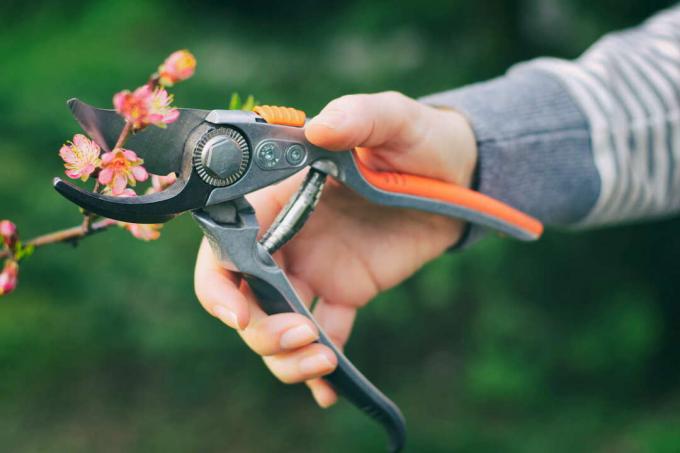Peaches can also be grown fruit bearing in cooler regions. The pruning of the peach tree is essential for successful cultivation.
Of the peach tree (Prunus persica) belongs to the stone fruits and is closely related to the Cherry tree (Sweet cherry: Prunus avium, Sour cherry: Prunus cerasus) related. Even if you may not believe it at first, the peach can also be grown successfully in the slightly warmer and not too frosty areas in German-speaking countries. As with almost all fruit trees, regular pruning of peaches can contribute to improved health and increased fruit yields. Since peaches, just like sour cherries, already bloom on annual wood, they can be cut a little more generously and carelessly than other fruit trees. After the cut, enough wood is formed on which fruit can grow in the next year.
"Contents"
- Peach tree: when to cut?
-
Cut the peach tree correctly
- Pruning young peach trees
- Pruning old peach trees
- Peach tree: cutting special shapes correctly
- Pruning peach columnar tree
- Cut peach espalier
- Cut mini peach tree
Peach tree: when to cut?
As with other fruit trees, peaches can also be pruned in winter (January to April) or summer (late June to early August). The early winter pruning in the course of the year has a positive effect on promoting growth and encouraging new growth. In moderation, this is particularly good for the peach, since it develops its flower buds on the young, fresh shoots (annual wood), from which fruits then arise. The summer pruning, on the other hand, slows down this favored growth somewhat and ensures that the shoots do not sprout in all directions and in thousands. Seen in this way, a combination of summer and winter pruning can be ideal for peach a balanced relationship between fruit development and growth of shoots or leaves achieve.

Cut the peach tree correctly
The question of all questions when pruning a tree is of course which shoot should give way and which one should stop. The decision for or against the shoot can be decisive for the suitable and ultimately promising growth habit of the tree. This also applies to the peach. However, no general statement can be made. The correct procedure depends above all on the age and the previous care that the tree has undergone.
Pruning young peach trees
It is best if the execution of editing measures is started right from the start. In the best case scenario, the first cut is already made with the planting. With the so-called plant pruning, all side shoots are radically cut back to a maximum of five eyes each. It also happens to the main shoot, which should protrude higher than all other shoots after the cut. It is important to focus on a single shoot as the main shoot and not to let the tree develop twins. In the following years, the so-called parental cuts follow. Here it is important to promote the branching of the tree, taking into account the optimal fruit set. Strong, healthy leading branches are identified and shortened at the tip of the shoot. Side shoots are sometimes removed entirely or not cut at all. It is advisable to shorten some of the side shoots in order to encourage the formation of annual wood.

When cutting the peach, however, there is one more specialty to consider. Two different types of shoots develop: real fruit shoots and false fruit shoots. The wrong fruit shoots also contain flower buds that fruits can develop, they throw them however, soon, as they do not develop enough leaf mass to adequately supply the fruits can. This is different with the real fruit shoots. Like a peach tree expert, you can tell the difference between real and false fruit shoots:
- False fruit shoots only develop single flower buds per node
- False fruit shoots only have a leaf bud at the tip of the shoot
- Real fruit shoots form two adjacent flower buds on each node, which also frame a leaf bud (triple buds)
Incorrect fruit shoots neither contribute to the supply of the tree, nor do they ensure an increase in the fruit yield. In any case, they should be completely cut out of the tree.
Everything you need to know about pruning peach trees here in a nutshell:
- It is essential to carry out a generous plant cut
- Cut the side shoots back to a maximum of five eyes
- Choosing a main shoot
- Leave the main shoot slightly higher than the side shoots
- Carry out training pruning regularly and generously in order to promote the formation of the fruiting, annual wood
- Determine the leading branches
- Shorten the guide branch tip
- Shorten the side shoots, leave them standing or remove them completely (keyword: "real" and "false" fruit wood)

Pruning old peach trees
The maintenance pruning of older peach trees should also be carried out regularly so that the tree can grow balanced relationship between fruit wood and older shoots, on which there is little or no fruit at all form, has. As already learned for the upbringing of younger peach trees, it is important to distinguish between real and fake fruitwood. In addition, the hierarchy between the main shoot, main shoots and side shoots must be observed. If necessary, depending on the individual case, it can make sense to remove stronger guide branches entirely if they take too much light from the rest of the tree and become too dominant. It is important to observe the tree after the cut and to draw conclusions for the next cutting measure from the cuts.
These products are ideal for cutting your shrubs, hedges and trees:- Felco secateurs: Manual pruning, pruning and pruning shears recommended for all types of cutting. In addition to plastic-coated handles, it has a precision adjustment system for the blade and anvil blade.
- Felco fruit tree and secateurs: Robust fruit tree and secateurs with wire cutter, sap groove and micrometer adjustment.
- Gardena telescopic arm scissors: Practical secateurs for effortless cutting of tall trees and dense shrubs from the ground.

Felco secateurs No. 11, red, 210 mm, 250g
43,46€
Details →

Felco fruit growing and secateurs No. 6
31,99€
Details →

GARDENA Telescope StarCut 410 plus
84,45€
Details →
Peach tree: cutting special shapes correctly
Fruit trees are often available in special growth forms. Whether as a column or a trellis - in principle, all fruit tree shapes can be traced back to one and the same plant. The only breakthrough to achieve and maintain a certain growth shape of the peach tree is ultimately only the right cut.

Pruning peach columnar tree
Column-shaped peach trees do not need a lot of space and with enough dedication they can even be cultivated successfully on the balcony. Under optimal conditions, they can boast abundant fruit yields. With the following pruning measures you can maintain or create a columnar growth habit for your peach tree:
- Shorten the main shoot twice a year
- Massively shorten side shoots twice a year (up to max. 15 cm)
- Differentiate between real and false fruit shoots
Cut peach espalier
Peach espaliers are particularly useful for using the heat from house walls and thus promoting the peaches' growth. But above all, that requires a skilful and regular cut. The following steps are to be observed when cutting peach espaliers:
- Peach espalier is best grown in a "fan", i.e. two main shoots that are approx. Walk to the left and right at an angle of 45 ° to each other
- Determine some of the side shoots leaving the main shoot as leading shoots and train them to grow horizontally
- Leave suitable side shoots for fruit formation every 15 to 20 cm from the main shoot
- Regularly shorten the side shoots leaving the main shoot and encourage the formation of annual wood
- Differentiate between real and false fruit shoots
Cut mini peach tree
Mini peach trees can find a place even on small balconies and terraces. But just because they don't get that big naturally doesn't mean you get the free ticket for cutting the dwarf peach. Since mini peach trees are not different from their big siblings in the biology of blossom and fruit formation differentiate and also bear fruit on annual wood, the pruning measures are the same to undertake. Depending on the condition and vigor, pruning measures for the mini peach tree are also appropriate in winter or summer.

Everything for peach tree - from planting to care - you can find out here.



